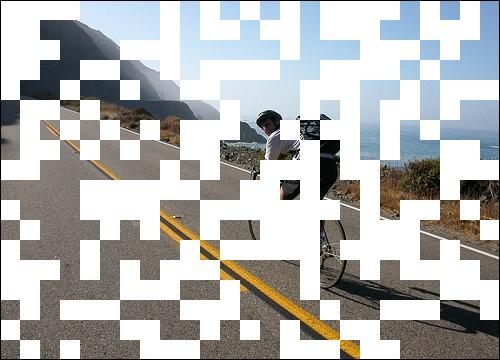Section: New Results
Learning and statistical models
Image categorization using Fisher kernels of non-iid image models
Participants : Ramazan Cinbis, Cordelia Schmid, Jakob Verbeek.
Bag of visual words treat images as an orderless sets of local regions and represent them by visual word frequency histograms. Implicitly, regions are assumed to be identically and independently distributed (iid), which is a very poor assumption from a modeling perspective; see Figure 5 for an illustration. In [13] , we introduce non-iid models by treating the parameters of bag-of-word models as latent variables which are integrated out, rendering all local regions dependent. Using the Fisher kernel we encode an image by the gradient of the data log-likelihood with respect to hyper-parameters that control priors on the model parameters. In fact, our models naturally generate transformations similar to taking square-roots, providing an explanation of why such non-linear transformations have proven successful. Using variational inference we extend the basic model to include Gaussian mixtures over local descriptors, and latent topic models to capture the co-occurrence structure of visual words, both improving performance. Our models yields state-of-the-art image categorization performance using linear classifiers, without using non-linear kernels, or (approximate) explicit embeddings thereof, e.g. by taking the square-root of the features.
|
Conditional gradient algorithms for machine learning
Participants : Zaid Harchaoui, Anatoli Juditsky [UJF] , Arkadi Nemirovski [Georgia Tech] .
In [17] we consider convex optimization problems arising in machine learning in high-dimensional settings. For several important learning problems, such as e.g. noisy matrix completion, state-of-the-art optimization approaches such as composite minimization algorithms are difficult to apply and do not scale up to large datasets. We study three conditional gradient-type algorithms, suitable for large-scale problems, and derive their finite-time convergence guarantees. Promising experimental results are presented on two large-scale real-world datasets.
Large-scale classification with trace-norm regularization
Participants : Matthijs Douze, Miro Dudik [Microsoft Research] , Zaid Harchaoui, Jérôme Malick [BiPoP Team Inria Grenoble] , Mattis Paulin [ETHZ] .
In [16] we introduce a new scalable learning algorithm for large-scale multi-class image classification,
based on the multinomial logistic loss and the trace-norm regularization penalty.
Reframing the challenging non-smooth optimization problem into a surrogate infinite-dimensional optimization problem with a regular
Tree-walk kernels for computer vision
Participants : Francis Bach [Inria SIERRA team] , Zaid Harchaoui.
In [25] we propose a family of positive-definite kernels between images, allowing to compute image similarity measures respectively in terms of color and of shape. The kernels consists in matching subtree-patterns called "tree-walks" of graphs extracted from the images, e.g. the segmentation graphs for color similarity and graphs of the discretized shapes or the point clouds in general for shape similarity. In both cases, we are able to design computationally efficient kernels which can be computed in polynomial-time in the size of the graphs, by leveraging specific properties of the graphs at hand such as planarity for segmentation graphs or factorizability of the associated graphical model for point clouds. Our kernels can be used by any kernel-based learning method, and hence we present experimental results for supervised and semi-supervised classification as well as clustering of natural images and supervised classification of handwritten digits and Chinese characters from few training examples.
Lifted coordinate descent for learning with trace-norm regularization
Participants : Miro Dudik [Microsoft Research] , Zaid Harchaoui, Jérôme Malick [BiPoP Team Inria Grenoble] .
In [14] we consider the minimization of a smooth loss with trace-norm regularization, which is a natural objective in multi-class and multi-task learning. Even though the problem is convex, existing approaches rely on optimizing a non-convex variational bound, which is not guaranteed to converge, or repeatedly perform singular-value decomposition, which prevents scaling beyond moderate matrix sizes. We lift the non-smooth convex problem into an infinitely dimensional smooth problem and apply coordinate descent to solve it. We prove that our approach converges to the optimum, and is competitive or outperforms the state of the art.



